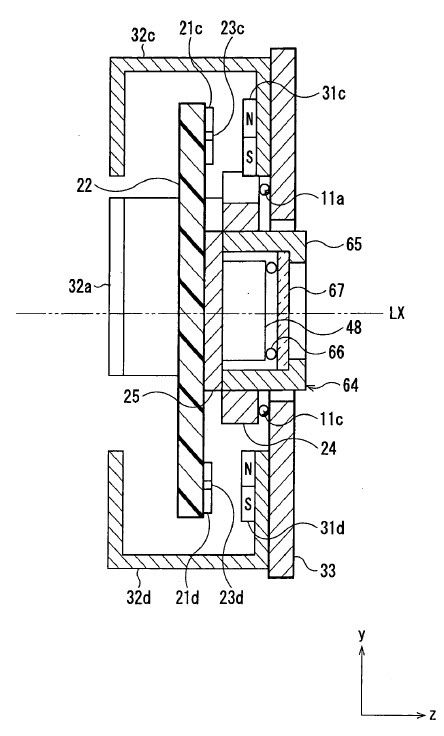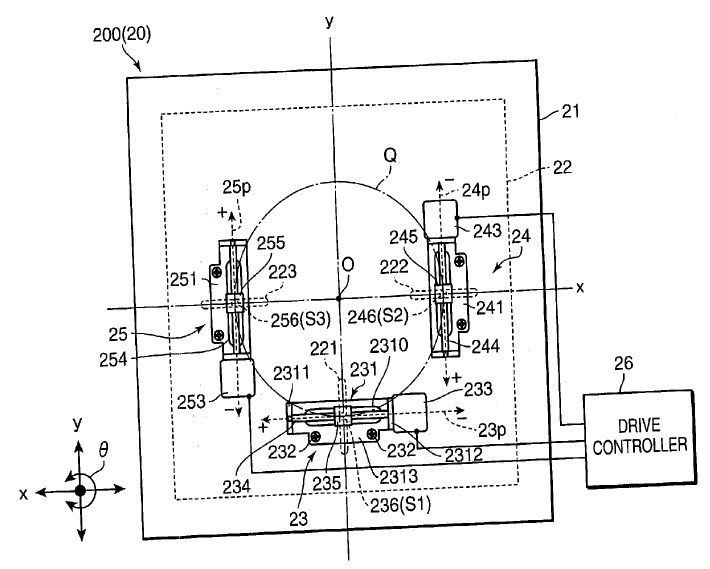* AS means Anti-Shake, which was named by the Konica Minolta (just called "Minolta" thereafter) in marketing term for their invention, and now is generalised to be called Super Steady Shot or SSS by Sony, which Sony actually has many ways to do the stabilisation (body IS is just one of their designs).
I found that some Pentaxians have been imagining and wrongly believed that the Minolta AS design and system is "much different" from Pentax's SR one and that the Pentax SR system is "far superior". So, I think it's the time for me to write a simple technical brief to break those myths and blast the bubbles, as it could be! ;->
So, first of all, we need to look at the right information about the designs. Let's begin with the relevant patents then. Do read the original documents in full, in which we can have most of the useful technical information to answer the question(s):-
Patent of Pentax: Publication No.: US2006067660 (A1), Filed: 2005-9-20
 (Left: Side View of the Pentax SR Module)
(Left: Side View of the Pentax SR Module)Patent of Minolta: Publication No.: US2006133786 (A1), Filed: 2005-8-24

(Above: Front View of the Minolta AS Module)
After that and next, let's look at the similarities of both designs:-
1. They both are in-body image stabilisation device which consists of a fixed part and a movable part where the imager seats on;
2. They both use electro-magnetic driving units (i.e., simply motors by basic definition) to correct the motions in 3 degrees of freedom (and only, i.e., X, Y and Z Angular/Rotational on the *same* 2-d plane);
3. They both have detectors for detecting the camera/hand-shake motions plus gravity;
4. They both have feedback controller to make the correction calculations and to instruct the driving units to move for counter actions. As such, the correction is achieved;
5. They both are closed-loop feedback system that the correction is being done in a continuous loop, "endlessly".
Now, let's look at the differences:-
1. The moving part of the Pentax' Anti-Shake system (as they named it in the patent) is on ball bearings whilst Minolta's is on "guides";
2. The moving part of the Pentax design is supposed to be "freely" moved (in a plane) and is held by magnetic force by 4 driving units;
3. The moving part of the Minolta design is confined within three guides which is then moved/held by 3 corresponding electro-magnetic driving units, or just motors;
4. As such, the moving method and hence the maths/calculations are different, although the degree of freedom of both system is actually the same at the end;
And, below are some guesses of mine in technical sense, as I have no more detailed information as could be read from the patent documents:-
1. Pentax's design may be more susceptible to external force including the gravity, as the the moving part/unit is just too free;
2. Electrical power is always needed (and wasted) to hold the moving unit in (the centre) position, even when the SR is supposed to have been turned off. The power is not less owing to the weight of the moving unit plus imager;
3. Whilst Minolta's design could be a bit more stable, it would have more friction as they are on the guide railings and the internal resistance (force wise) of the driving units might be higher as well;
4. But the stabler design (and maybe more friction as well) of the Minolta design could help to save unnecessary additional power consumption when the AS is turned off, i.e., minimal electrical power is required to hold the moving part (thus the imager) in position, by applying just minimal magnetic force;
5. Whilst both designs could be designed to have a rest position towards the direction of the gravity so that zero power consumption is achieved to hold the sensor position when shake reduction is not required, the imager will actually be de-centred downwards against the optical axis of the lens and as such it is impractical to do so!
I think my above observations and analyses (or maybe just wild guesses for some) would end here. It's your take now! Do read the drawings and diagrams followed by reading the detailed descriptions in the patents more thoroughly if you are interested and do have the time (I've yet read them somehow roughly and haven't dug too deep into them actually). I'd be glad if you could provide some additional information and findings of your own about more similarities or differences plus pros and cons of both designs. Sharing is always good which is the true power and meaning of the Internet! :-)
Read Also:-
Cures to High Fever of Video/in-body ISed DSLRs.. :-o ;->
Working Principle of the New "DC" Motor (Patent Paper Included)
Live View & AF Methods Fully Dissected
All Other Technical Articles at This Blog